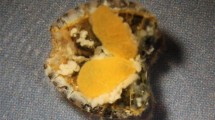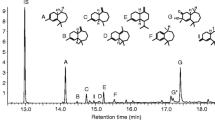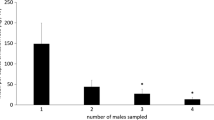Abstract
Gregarious nymphs of Schistocerca gregaria and Locusta migratoria migratorioides are often seen to march together in common bands in the field. In the present study, the intraspecific aggregation responses of nymphal and older stages of the two insects were compared with their interspecific responses. Unlike S. gregaria, L. m. migratorioides shows a lesser pattern of stage and sex differentiation in its aggregation pheromone biology. Thus, although fifth-instar nymphs did not respond significantly to the adult pheromone, adults responded significantly to the nymph pheromone. No cross-stage aggregative responses occur in S. gregaria. In the adults of S. gregaria, production of the pheromone is male-specific; in L. m. migratorioides both sexes induced a significant level of aggregation from conspecifics. Aggregation assays between corresponding stages of the two species showed stronger interaction between the nymphal stages than between the adults and account for the frequent occurrence of mixed hopper bands in the field. GC-EAD studies of volatiles of nymphal and adult stages by using antennal preparations from both species also showed significant interspecies reactivities. GC-MS analyses showed that of S. gregaria nymphal pheromone components (C6 and C8 to C10 straight-chained aldehydes and acids and the fecal phenols, guaiacol and phenol), the acids and phenols constitute the common components of nymphal stages. Phenylacetonitrile, the major component of S. gregaria adult aggregation pheromone, is present in L. m. migratorioides nymphal volatiles, albeit at a lower level. Unlike S. gregaria adult pheromone blend, which is made up wholly of benzene derivatives, the volatile emissions of L. m. migratorioides adults is dominated by aliphatic aldehydes and alcohols. The possible role of cross-aggregation effects in mutually facilitating phase transformation of the two species is discussed.
Similar content being viewed by others
REFERENCES
Arn, H., Stadler, E., and Rauscher, S. 1975. The electroantennographic detector—a selective and sensitive tool in the gas chromatographic analysis of insect pheromones. Z. Naturforsch. 30C:722–725.
El-Bashir, S., and Abdel-Rahman, H. E. 1991. Factors inducing phase change in the desert locust, Schistocerca gregaria (F) at recession and breeding habitats. 19th ICIPE Annual Report: ICIPE Science Press, Nairobi, Kenya, pp. 85–86.
Fuzeau-Braesch, E., Genin, E., Jullien, R., Knowles, E., and Papin, C. 1988. Composition and role of volatile substances in the atmosphere surrounding two gregarious locusts, Locusta migratoria and Schistocerca gregaria. J. Chem. Ecol. 14:1023–1033.
Gillett, S. D., Packham, J. M., and Papworth, S. J. 1976. Possible pheromonal effects on aggregation and dispersion in the desert locust, Schistocerca gregaria. Acrida 4:287–298.
Johnston, H. B., and Buxton, D. R. 1949. Field observations on locusts in East Africa. Anti-Locust Bulletin. Anti-Locust Research Center, British National Museum (Natural History), London, SW7, 5 pp.
Mahamat, H., Hassanali, A., Odongo, H., Torto, B., and El-Bashir, S. 1993. Studies on the maturation-accelerating pheromone of the desert locust, Schistocerca gregaria (Forskal). Chemoecology 4:159–164.
NIST Registry of Mass Spectral Data, 1995. Mass Lynx Libraries, Wiley Version 6.0. VG Organic, England.
Njagi, P. G. N., and Torto, B. 1996. Responses of nymphs of desert locust, Schistocerca gregaria to volatiles of plants used as rearing diet. Chemoecology 7:172–178.
Njagi, P. G. N., Torto, B., Obeng-Ofori, D., and Hassanali, A. 1996. Phase-independent responses to phase-specific aggregation pheromone in adult desert locusts, Schistocerca gregaria (Orthoptera: Acrididae). Physiol. Entomol. 21:131–137.
Obeng-Ofori, D., Torto, B., and Hassanali, A. 1993. Evidence for mediation of two releaser pheromones in the aggregation behavior of the gregarious desert locust, Schistocerca gregaria (Orthoptera: Acrididae). J. Chem. Ecol. 19:1665–1676.
Obeng-Ofori, D., Njagi, P. G. N., Torto, B., Hassanali, A., and Amiani, H. 1994a. Sex differentiation studies relating to releaser aggregation pheromones of the desert locust, Schistocerca gregaria. Entomol. Exp. Appl. 73:85–91.
Obeng-Ofori, D., Torto, B., Njagi, P. G. N., Hassanali, A., and Amiani, H. 1994b. Fecal volatiles as part of the aggregation pheromone complex of the desert locust, Schistocerca gregaria (Orthoptera: Acrididae). J. Chem. Ecol. 20:2078–2087.
Ochieng, S. 1997. Odour detection in the desert locust S. gregaria: Antennal structure and function. PhD thesis. Lund University, Lund, Sweden, 113 pp.
Odum, E. P. 1971. Fundamentals of Ecology, 3rd ed. WB Saunders, Philadelphia.
SAS Institute. 1988. SAS Users Guide. Statistics. Version 6.03 ed. Cary, North Carolina.
Steedman, A. (ed.). 1988. Locust Handbook, 2nd ed. Overseas Development Natural Resource Institute, London, 180 pp.
Torto, B., Obeng-Ofori, D., Njagi, P. G. N., Hassanali, A., and Amiani, H. 1994. Aggregation pheromone system of adult gregarious desert locust Schistocerca gregaria. J. Chem. Ecol. 20:1749–1762.
Torto, B., Njagi, P. G. N., Hassanali, A., and Amiani, H. 1996. Aggregation pheromone system of nymphal gregarious desert locust Schistocerca gregaria. J. Chem. Ecol. 22:2273–2281.
Uvarov, B. P. 1966. Grasshoppers and Locusts. Cambridge University Press, Cambridge, 496 pp.
Author information
Authors and Affiliations
Rights and permissions
About this article
Cite this article
Niassy, A., Torto, B., Njagi, P.G.N. et al. Intra- and Interspecific Aggregation Responses of Locusta migratoria migratorioides and Schistocerca gregaria and a Comparison of Their Pheromone Emissions. J Chem Ecol 25, 1029–1042 (1999). https://doi.org/10.1023/A:1020873623852
Issue Date:
DOI: https://doi.org/10.1023/A:1020873623852




